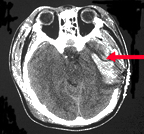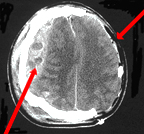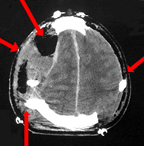

Our
mission is to reduce the number of injuries and deaths due to
injuries,
through prevention, improved trauma care, and improved rehabilitation.
![]()
![]()
![]()
![]()
![]()
![]()
![]()
Helmets reduce the risk of death by 29% and are 67% effective in
preventing brain injuries to motorcycle riders. (NHTSA)
Motorcyclists are about 18 times as likely as passenger car occupants to die in a traffic crash and three times as likely to be injured. (NHTSA)
Motorcycles make up less than 2% of all registered vehicles and only 0.4% of all vehicle miles traveled, but motorcyclists account for 7% of total traffic fatalities. (NHTSA)
In 2000, 2,862 motorcycle occupants were killed on American roads, an alarming increase of 15% from 1999. (NHTSA)
April 19, 2002
.
Despite the fact that helmets have been shown to save lives, reduce injuries, and save public funds, in California and other states where helmet laws are in effect, there is an annual battle to overturn helmet laws. Many states have repealed their all-rider laws, "replacing" them with minimum insurance coverage requirements or age-specific laws. The result is that motorcycle helmet deaths are increasing. California, which has more than 10 percent of the nation's riders, has recently considered AB 2700, a motorcycle helmet law repeal. The bill narrowly failed to pass the Assembly Transportation Committee, but it is likely it will come up for a vote again.
Those opposed to helmet laws feel that the risk of a crash is
their own responsibility and  that helmet laws infringe upon their right to
ride with the wind in their hair. The reality is that from the moment
the motorcyclist hits the pavement, society foots the bill, and we all pay in many
other ways.
that helmet laws infringe upon their right to
ride with the wind in their hair. The reality is that from the moment
the motorcyclist hits the pavement, society foots the bill, and we all pay in many
other ways.
The young man in the photos on this page was not wearing a helmet when he crashed his motorcycle, and sustained a fractured skull and severe brain injury. He must now wear a special helmet for approximately six months to protect his brain until the skull bone can be replaced. It is uncertain what level of mental functioning this young man will be able to regain.
 Immediately
after the crash he was taken to the operating room
where a blood clot was removed. Physicians were unable to replace the skull
bone due to massive brain swelling.
Immediately
after the crash he was taken to the operating room
where a blood clot was removed. Physicians were unable to replace the skull
bone due to massive brain swelling.
He was admitted to the Intensive Care
Unit, where  despite all medical treatment, the intracranial pressure
rose.
despite all medical treatment, the intracranial pressure
rose.
He was returned to the operating
room where the skull bone on the opposite side was removed to operate
on a new blood clot. Afterwards, he remained in the Intensive Care
Unit for 50 days.
He had no
medical insurance. Trauma care for his first admission
cost $556,000.
Twenty states and the District of Columbia require helmets by all motorcycle drivers and passengers. Twenty-seven other states have laws covering only some riders, particularly those under 18. Three states--Colorado, Illinois, and Iowa--have no helmet laws whatsoever.
For additional information see:
Advocates for Highway and Auto Safety Fact Sheet
 |
 |
|---|